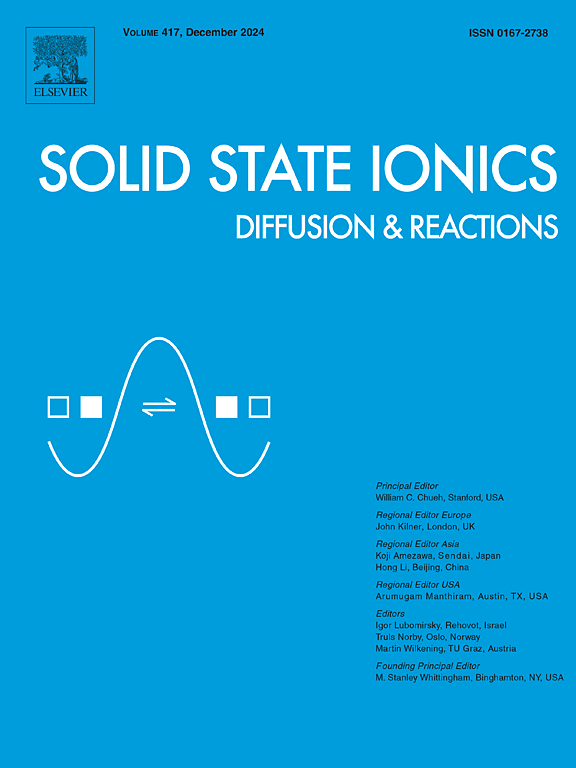钠掺杂高熵氧化物的晶界电导率可调
IF 3
4区 材料科学
Q3 CHEMISTRY, PHYSICAL
引用次数: 0
摘要
对锂离子电池的安全性和来源的担忧促使了对钠基系统的重大研究。高熵氧化物(HEO)含有五种或更多等摩尔量的氧化物成分,非常适合电池应用,因为它们能够容纳大量的移动电荷载体(如钠),同时也表现出良好的循环稳定性、导电性和电池容量保持性。本文研究了钠掺杂、工艺和微观结构对(Co,Cu,Mg,Ni,Zn)1-xNaxO块体烧结中电荷输运的影响。我们发现电导率随着掺杂量的增加而增加,在x = 0.33时达到1.4 × 10−5 S∙cm−1。这种增加很大程度上归因于高晶界电导率,这源于加工过程中晶界形成的NaxCoO2层状结构。x射线衍射和透射电镜证实了层状结构的存在,而电化学阻抗谱则强调了对阻抗响应的独特贡献。讨论了晶界和体积对电荷输运的相对贡献,以及如何利用加工条件和成分有效地设计掺杂HEO材料的晶界。本文章由计算机程序翻译,如有差异,请以英文原文为准。

Tunable grain boundary conductivity in sodium doped high entropy oxides
Concerns with the safety and sourcing of lithium-ion batteries have prompted significant research into sodium-based systems. High entropy oxides (HEO), which contain five or more oxide components in equimolar amounts, are well suited for battery applications due to their ability to accommodate a substantial quantity of mobile charge carriers (such as sodium), while also demonstrating promising cycling stability, electrical conductivity, and battery capacity retention. Here we investigate the underexplored influence of sodium doping, processing, and microstructure on charge transport in bulk sintered (Co,Cu,Mg,Ni,Zn)1-xNaxO. We find that the conductivity increases with increasing dopant amount, up to 1.4 × 10−5 S∙cm−1 at x = 0.33. Much of this increase is attributed to the high grain boundary conductivity, which originates from a NaxCoO2 layered structure that forms in the grain boundaries during processing. X-ray diffraction and transmission electron microscopy confirm the presence of the layered structure, while electrochemical impedance spectroscopy highlights the distinct contribution to the impedance response. The relative contributions of the grain boundaries and the bulk to the charge transport are discussed, along with how processing conditions and composition can be used to effectively engineer grain boundaries in doped HEO materials.
求助全文
通过发布文献求助,成功后即可免费获取论文全文。
去求助
来源期刊

Solid State Ionics
物理-物理:凝聚态物理
CiteScore
6.10
自引率
3.10%
发文量
152
审稿时长
58 days
期刊介绍:
This interdisciplinary journal is devoted to the physics, chemistry and materials science of diffusion, mass transport, and reactivity of solids. The major part of each issue is devoted to articles on:
(i) physics and chemistry of defects in solids;
(ii) reactions in and on solids, e.g. intercalation, corrosion, oxidation, sintering;
(iii) ion transport measurements, mechanisms and theory;
(iv) solid state electrochemistry;
(v) ionically-electronically mixed conducting solids.
Related technological applications are also included, provided their characteristics are interpreted in terms of the basic solid state properties.
Review papers and relevant symposium proceedings are welcome.
 求助内容:
求助内容: 应助结果提醒方式:
应助结果提醒方式:


